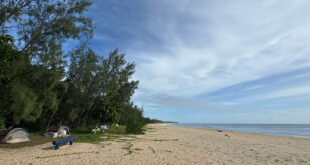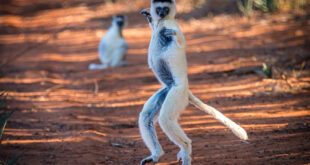Dinosaurs and pterosaurs were true giants, that is the general opinion about the lizards of prehistoric times. The largest creature that ever lived on earth was the dinosaur Argentinosaurus. With a body length of 30 metres and weighing an incredible 70 tonnes, it surpassed the famous Tyrannosaurus rex by far. Its largest counterpart in the air was the pterosaur Quetalcoatlus. The pterosaur with the unpronounceable name had an incredible wingspan of up to 13 metres and a body weight of up to 200 kg.
An ancestor of both giants probably lived in Madagascar. But he was the exact opposite of the giants: He was tiny. Not to say one of the smallest that ever existed. His name was Kongonaphon kely and he was about the size of a coffee cup today. You could have easily put the miniature dinosaur in your pocket if humans or trousers had existed when he was alive.
But let’s start the story from the beginning. In 1998, the first fossils of the tiny creature were discovered during excavations in the southwest of Madagascar in the Makay Massif. The researchers were astonished when they discovered tiny skeletal fragments between two sandstone blocks: Parts of a head, a femur, ankle bones, vertebrae, and parts of an upper arm and lower leg. The small dinosaur measured just ten centimetres in height. Even more surprising was that the find was not a juvenile, as initially assumed, but an adult dinosaur.
However, it took 22 years until Kongonaphon kely was actually described as a separate species by US American and Malagasy researchers in 2020. Today, it is assumed that the tiny creature lived around 237 million years ago. In the so-called Triassic, when the dinosaurs and pterosaurs were still in the first stages of their development.
Due to its small body size, the tiny dinosaur could have made special ecological niches its own. Its insectivorous diet alone gave it an advantage over its then predominantly carnivorous competitors. The light body could have given rise to the bipedal gait that many later dinosaurs used and the ability to fly, which distinguished the pterosaurs. A smaller body also usually means that it is harder for them to retain their own body heat. This could have favoured the development of feathers. Today, it is assumed that many dinosaurs and pterosaurs actually not only wore scales, but also feathers.
Traces on the teeth reveal that Kongonophon kely fed mainly on insects, in keeping with its size. Incidentally, its name was chosen accordingly: A mixture of Greek and Malagasy, which together means “little bug butcher”. Incidentally, Kongonophon kely is also the first so-called laperpetid ever discovered in Africa. Until then, the ancestors of the dinosaurs and pterosaurs were only known from other parts of the world. This confirms what we have actually known for a long time: Madagascar is always good for a surprise. No matter how small it may be.
- A tiny ornithodiran archosaur from the Triassic of Madagascar and the role of miniaturization in dinosaur and pterosaur ancestry
PNAS 117 (30), pp. 17932-17936 | USA 2020 | Authors: Christian F. Kammerer, Sterling J. Nesbitt, John J. Flynn, Lovasoa Ranivoharimanana, André R. Wyss
 MADAMAGAZINE Your Magazine about Madagascar
MADAMAGAZINE Your Magazine about Madagascar




